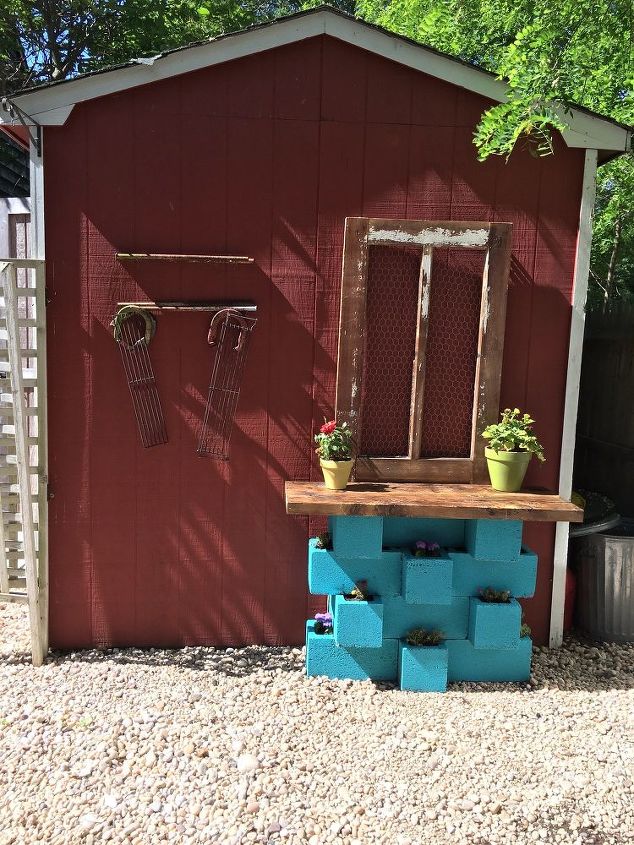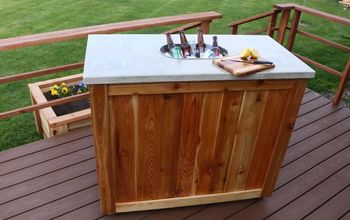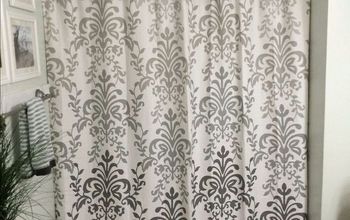Outdoor Cinder Block Wet Bar/Gardening Station

by
Rob & Coco, Hometalk Team
(IC: paid contributor)
8 Materials
$75
2 Days
Advanced
Ok are y'all ready for this one?! I saw this idea and had to take a stab at it myself...between the reclaimed scaffolding beams laying around behind my husband's garage and the old door we had leaning beside them, this was a perfect project to create. Better than anything is the fact that my in-laws were celebrating their 28th wedding anniversary the same weekend I decided to create this bar so of course, HAPPY ANNIVERSARY to them!!--they got this as their gift. They just got rid of their pool this year and redesigned the area as a hang out/fire pit area so this cinder block bar fits perfectly in the space. The best thing about this project is it's so versatile--you can use it for just about anything you need it for, whether it be a little gardening station to hang your gardening tools and to assemble your flowers pots, or of course as part of your entertainment area when you have guests over. You can assemble this on your back deck, or in my case, on the ground. The only extra tidbit I'd add is you will want a partner for this project--the cinderblocks are super heavy and there are some steps that would just be easier with a second set of hands.
STEP 1: You're going to want to prepare your door (if you decide to use one). The door I had was already chipped up pretty good so it wasn't that difficult to get the majority of the remaining paint off, and I didn't necessarily want it completely stripped. For this step, you can simply use a wire brush to remove the excess chipped paint if you're using a reclaimed door, or if you're like me and have a brush sander, using it will get the job done quicker. Once you've finished removing the paint chips, take a dry rag and wipe off any debris that is left behind.
STEP 2: Next, you'll want to either paint, stain, glaze, and/or seal your door. In my case, I brushed on (with a latex brush) a clear satin sealer (spar urethane) just to protect it how it was. I loved how it made the natural wood color look rich--I felt it just accentuated it's natural beauty and created a rustic look. You'll want to let your door dry, then flip it to coat the opposite side. Regardless of what style you go with, you'll want to seal the door with exterior window/door sealer to prevent rotting or any future weathering.
STEP 3 (Optional): While your door is drying, start painting your cinder blocks--of course, you can opt to leave your cinder blocks as is instead--but my mother-in-law wanted a tropical blue so that's what she got. Because I knew they were going to be stacked and the insides weren't going to be seen, I only painted the outside edges and sides. I wasn't sure at the time what blocks were going to go where so I painted all the sides since I had a lot of paint. If you really want to plan this out, you can go ahead and mock up your blocks to figure out what sides will be exposed and need painted.
*Note: Make sure to get the water blocker brush in the photo, or one similar. These brushes will help get into the pores of the cinder blocks. If you don't want to see any grey, you'll want to lay the paint on thick and these brushes are pretty good with only having to do one coat if that's the look you're going for.
STEP 4: Warning: Missing photos! Not sure what happened to my bar top-making photos. I apologize!! Next, you'll want to measure whatever material you're going to use for your bar top. In my case, I had one long piece of scaffolding my husband had laying around so I measured the width of my door, then added 2-3" on either side. I made a clean cut at the very end of my scaffolding board so that it was square (i.e.: no jagged/yucky end), then I cut the board at the total length that I wanted my bar top to be which was 48". Once I cut my board down, I used two 48" long boards from it to make my bar top. *Note: You don't want your bar top to be much longer than your door is wide because your cinder blocks are only 3 blocks wide, so you want your bar top to be stable, not wobbly.
STEP 5 (Optional): For the window panes on my door, I didn't want them to be left empty and the glass wasn't salvageable so I thought chicken wire would be a cool addition. This way, if my in-laws wanted to use it as a gardening station, they could easily hang gardening tools or use a clothes pin to attach packets of seeds--or--hang a bottle opener, little chalkboard drink signs or other random bar/drink station items. I'm sure the chicken wire will eventually rust but I think it'll add character to the whole look of the bar. This step can probably be done with a regular industrial stapler but I had my air pressure staple gun which made this step quick and easy.
STEP 6 (Optional): If you want to add plants in some of your cinder blocks like I did, you can use landscaping wire or some other mesh but I wasn't sure how I could implement that element and it last so I decided to use wood instead. I cut the wood 1/4" smaller than the opening and hammered them in using another block of wood. You can't see it in the photo but because of the tampered openings in the cinder blocks, there are small spaces where water can slip through when it rains or when you water your plants. I made a total of 8 wooden blocks since I was only having 8 openings with plants.
STEP 7: Choose where you want your bar to be and make sure the area is level. If you're working on stone like me, take a tamper and beat the area down (in my case I enlisted the help of my husband to do this since there was no way my little scrawny arms were going to be able to lift a tamper). Use a level to ensure that the area is level (again, not sure how else to phrase this - haha!), then place your first cinder block down where you want it (preferably centered with your door).
STEP 8: Next, it's time to assemble your bar; you'll want a total of 12 cinder blocks, 4 layers of 3 blocks. ***IMPORTANT NOTE: you'll want to start with the blocks in the same way the first photo is with the level on the top--this will ensure that the final/top layer of cinder blocks will be set in a way to be sufficient to hold your bar top! Lay your first 3 blocks and use a level to ensure they're level (sorry, not sure how else to phrase that!). Then, using 1 cinder block, mock up where the next layer of cinder blocks will sit and simply mark where the end of the block sits. Sit the cinder block to the side and apply your adhesive. ***ANOTHER IMPORTANT NOTE: be generous with the adhesive towards the back of the blocks but don't glop it on the front because you'll experience the glue bleeding through the edges of the blocks. Repeat this step until all 4 layers of your blocks are assembled. If you do experience any bleeding, just let it dry--don't try getting it off right away or you may smear it.
STEP 9: Now that your blocks are assembled, gently lay your bar top on--if you used two pieces of wood like me, lay the back one down first (of course with the side you want seen, facing up), then lay the next one down closest to you. Take two more cinder blocks that you aren't using, or something else that has pretty heavy weight, and gently lay them on top of your bar. Let it set overnight.
STEP 10: Clean up. If you experienced any bleeding with your adhesive, simply scrape it off with a putty knife or razor blade. Then, touch up the paint to cover any adhesive you may be able to see.
Finally, step back and admire your work. Add plants and/or flowers in your cinder block openings if you choose to, or you can use them as cubbies for other things.
Enjoyed the project?
Resources for this project:
See all materials
Any price and availability information displayed on [relevant Amazon Site(s), as applicable] at the time of purchase will apply to the purchase of this product.
Hometalk may collect a small share of sales from the links on this page.More info
Published June 10th, 2016 2:09 PM
Comments
Join the conversation
2 of 46 comments
















































Frequently asked questions
Have a question about this project?
What kind of adhesive
Where do I get cinder blocks from?
I clicked on the link and it takes me to Amazon and shows miniature cinder blocks.
How was the soil put for the flowers or did they stay in the pots?